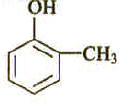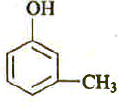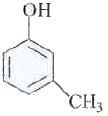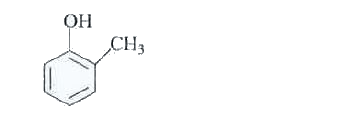An organic compound (A) (C8H8O3) was insoluble in water, dilute HCI, and NaHCO3. It was soluble in NaOH. A solution of (A) in dilute NaOH was boiled and steam distilled and distillate was reacted with NaOH to give a yellow precipitate. The alkaline residue is acidifield to give a solid (B) (C7H6O3). (B) dissolves in aqueous NaHCO3 with the evolution of gas. Identify (A) and (B).
To solve the problem, we need to identify the organic compounds (A) and (B) based on the information provided. Let's break down the steps systematically.
Step 1: Analyze the Molecular Formula of Compound (A)
Given:
- Molecular formula of (A) = C₈H₈O₃
To determine the degree of unsaturation, we use the formula:
Degree of Unsaturation=(2nc+2−nh)2
where nc is the number of carbon atoms and nh is the number of hydrogen atoms.
Calculating the degree of unsaturation:
Degree of Unsaturation=(2×8+2−8)2=(16+2−8)2=102=5
Step 2: Interpret the Degree of Unsaturation
A degree of unsaturation of 5 indicates:
- There is a benzene ring (which accounts for 4 degrees of unsaturation).
- There is 1 additional degree of unsaturation, suggesting a double bond in the side chain.
Step 3: Solubility Characteristics
- Compound (A) is insoluble in water, dilute HCl, and NaHCO₃.
- Compound (A) is soluble in NaOH, indicating the presence of an ester group.
Step 4: Reaction with NaOH and Steam Distillation
When (A) is treated with NaOH and boiled, it undergoes hydrolysis to form a phenolic compound and a carboxylate salt. The steam distillate reacts with NaOH to give a yellow precipitate, indicating the formation of a phenolic compound.
Step 5: Acidification of Alkaline Residue
The alkaline residue is acidified to yield a solid (B) with the formula C₇H₆O₃.
Step 6: Identify Compound (B)
Given that (B) is soluble in NaHCO₃ with the evolution of gas, we can deduce that (B) is likely a carboxylic acid, specifically salicylic acid (C₇H₆O₃), which can release CO₂ when reacting with NaHCO₃.
Step 7: Identify Compound (A)
Since (A) is an ester that hydrolyzes to form salicylic acid, we can conclude that (A) is methyl salicylate (C₈H₈O₃).
Final Identification
- Compound (A): Methyl salicylate (C₈H₈O₃)
- Compound (B): Salicylic acid (C₇H₆O₃)
Given:
- Molecular formula of (A) = C₈H₈O₃
Degree of Unsaturation=(2nc+2−nh)2
where nc is the number of carbon atoms and nh is the number of hydrogen atoms.
Degree of Unsaturation=(2×8+2−8)2=(16+2−8)2=102=5
A degree of unsaturation of 5 indicates:
- There is a benzene ring (which accounts for 4 degrees of unsaturation).
- There is 1 additional degree of unsaturation, suggesting a double bond in the side chain.
- Compound (A) is insoluble in water, dilute HCl, and NaHCO₃.
- Compound (A) is soluble in NaOH, indicating the presence of an ester group.
When (A) is treated with NaOH and boiled, it undergoes hydrolysis to form a phenolic compound and a carboxylate salt. The steam distillate reacts with NaOH to give a yellow precipitate, indicating the formation of a phenolic compound.
The alkaline residue is acidified to yield a solid (B) with the formula C₇H₆O₃.
Given that (B) is soluble in NaHCO₃ with the evolution of gas, we can deduce that (B) is likely a carboxylic acid, specifically salicylic acid (C₇H₆O₃), which can release CO₂ when reacting with NaHCO₃.
Since (A) is an ester that hydrolyzes to form salicylic acid, we can conclude that (A) is methyl salicylate (C₈H₈O₃).
- Compound (A): Methyl salicylate (C₈H₈O₃)
- Compound (B): Salicylic acid (C₇H₆O₃)
Topper's Solved these Questions
- ALCOHOL,PHENOL AND ETHERSBOOK - CENGAGE CHEMISTRY ENGLISHCHAPTER - ALCOHOL,PHENOL AND ETHERSEXERCISE - Exercises Concept Application
33 Videos
- ALCOHOL,PHENOL AND ETHERSBOOK - CENGAGE CHEMISTRY ENGLISHCHAPTER - ALCOHOL,PHENOL AND ETHERSEXERCISE - Exercises Linked Comprehension
60 Videos
- ALCOHOL,PHENOL AND ETHERSBOOK - CENGAGE CHEMISTRY ENGLISHCHAPTER - ALCOHOL,PHENOL AND ETHERSEXERCISE - Solved Examples
17 Videos
- ALIPHATIC AND AROMATIC ALDEHYDES AND KETONESBOOK - CENGAGE CHEMISTRY ENGLISHCHAPTER - ALIPHATIC AND AROMATIC ALDEHYDES AND KETONESEXERCISE - Archives Subjective
26 Videos
Similar Questions
Compound A (C7H8O) is insoluble in water, dilute HCl & aqueous NaHCO3, but it dissolves in dilute NaOH. When A is treated with Br2 water it is converted into a compound C7H5Obr3 rapidly. The structure of A is:
View SolutionAn organic compound X(C4H8O2) gives positive test with NaOH and Phenopthalein. Structure of X will be:
View Solution
Knowledge Check
A compound P (C7H8O) is insoluble in water, dilute HCl, NaHCO3 but dissolve in dilute NaOH. When P is treated with bromine-water, it is converted into a compound of formula C7H7OBr. Compound P is :
A B
B C
C D
D
A compound 'A' (C7H8O) is insoluble in water, dilute Hcland aqueous NaHCO3 but soluble in dilute NaOH. When Ais treated with Br2−H2O, it is converted into a compound of formula C7H5Obr3. Compound A is :
A B
B C
C D
D
Compound 'P', C7H8O is insoluble in water, dilute HCl and NaHCO3 . It dissolves in dilute NaOH . When P is treated with Br2−H2O , it converts rapidly into a compound of formula C7H5OBr3 . Identify structure of :
A B
B C
C D
D
A compound D(C8H10O) upon treatement with alkaline solution of iodine gives a yellow precipitate. The fibtrate on acidification gives a white solid E(C7H6O2). Write the structures of D,E .
View SolutionCompound (A) C8H9Br. Gives a white precipitate when warmed with alcoholic AgNO3. Oxidation of (A) gives an acid (B). C8H6O4. (B) easily forms anhydride on heating. Identify the compound (A)
View SolutionCompound (A) C8H9Br. Gives a white precipitate when warmed with alcoholic AgNO3. Oxidation of (A) gives an acid (B). C8H6O4. (B) easily forms anhydride on heating. Identify the compound (A)
View SolutionCompound A (C7H8O) is insoluble in water, dilute HCI & aqueous NaHCO3 , but it dissolves in dilute NaOH. When A is treated with Br2 water it is converted into a compound C7H5OBr3 rapidly. The structure of A is :
View SolutionAn aromatic compound A of the molecular formula C8H10O on reaction with iodine and dilute NaOH gives a yellow precipitate. The structure of the compound is expected to be :
View Solution
